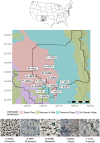Landscape characteristics shape surface soil microbiomes in the Chihuahuan Desert
- PMID: 37350785
- PMCID: PMC10282155
- DOI: 10.3389/fmicb.2023.1135800
Landscape characteristics shape surface soil microbiomes in the Chihuahuan Desert
Abstract
Introduction: Soil microbial communities, including biological soil crust microbiomes, play key roles in water, carbon and nitrogen cycling, biological weathering, and other nutrient releasing processes of desert ecosystems. However, our knowledge of microbial distribution patterns and ecological drivers is still poor, especially so for the Chihuahuan Desert.
Methods: This project investigated the effects of trampling disturbance on surface soil microbiomes, explored community composition and structure, and related patterns to abiotic and biotic landscape characteristics within the Chihuahuan Desert biome. Composite soil samples were collected in disturbed and undisturbed areas of 15 long-term ecological research plots in the Jornada Basin, New Mexico. Microbial diversity of cross-domain microbial groups (total Bacteria, Cyanobacteria, Archaea, and Fungi) was obtained via DNA amplicon metabarcode sequencing. Sequence data were related to landscape characteristics including vegetation type, landforms, ecological site and state as well as soil properties including gravel content, soil texture, pH, and electrical conductivity.
Results: Filamentous Cyanobacteria dominated the photoautotrophic community while Proteobacteria and Actinobacteria dominated among the heterotrophic bacteria. Thaumarchaeota were the most abundant Archaea and drought adapted taxa in Dothideomycetes and Agaricomycetes were most abundant fungi in the soil surface microbiomes. Apart from richness within Archaea (p = 0.0124), disturbed samples did not differ from undisturbed samples with respect to alpha diversity and community composition (p ≥ 0.05), possibly due to a lack of frequent or impactful disturbance. Vegetation type and landform showed differences in richness of Bacteria, Archaea, and Cyanobacteria but not in Fungi. Richness lacked strong relationships with soil variables. Landscape features including parent material, vegetation type, landform type, and ecological sites and states, exhibited stronger influence on relative abundances and microbial community composition than on alpha diversity, especially for Cyanobacteria and Fungi. Soil texture, moisture, pH, electrical conductivity, lichen cover, and perennial plant biomass correlated strongly with microbial community gradients detected in NMDS ordinations.
Discussion: Our study provides first comprehensive insights into the relationships between landscape characteristics, associated soil properties, and cross-domain soil microbiomes in the Chihuahuan Desert. Our findings will inform land management and restoration efforts and aid in the understanding of processes such as desertification and state transitioning, which represent urgent ecological and economical challenges in drylands around the world.
Keywords: archaea; bacteria; biocrust; cyanobacteria (blue-green algae); dryland; fungi; soil geomorphic template; topsoil.
Copyright © 2023 Hansen, James, Anderson, Meredith, Dominguez, Pombubpa, Stajich, Romero-Olivares, Salley and Pietrasiak.
Conflict of interest statement
The authors declare that the research was conducted in the absence of any commercial or financial relationships that could be construed as a potential conflict of interest.
Figures





References
-
- Alves R. J. E., Kerou M., Zappe A., Bittner R., Abby S. S., Schmidt H. A., et al. . (2019). Ammonia oxidation by the arctic terrestrial Thaumarchaeote Candidatus Nitrosocosmicus arcticus is stimulated by increasing temperatures. Front. Microbiol. 10:1571. doi: 10.3389/fmicb.2019.01571, PMID: - DOI - PMC - PubMed
-
- Anderson J. (2022a). Jornada Basin LTER: wireless meteorological station at NPP C-CALI site: daily summary data: 2013—ongoing ver 36. Environmental Data Initiative.
-
- Anderson J. (2022b). Jornada Basin LTER: wireless meteorological station at NPP C-GRAV site: daily summary data: 2013—ongoing ver 34. Environmental Data Initiative.
-
- Anderson J. (2022c). Jornada Basin LTER: wireless meteorological station at NPP C-SAND site: daily summary data: 2013—ongoing ver 34. Environmental Data Initiative.

